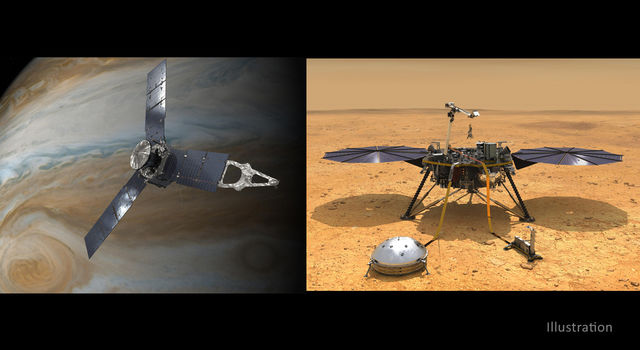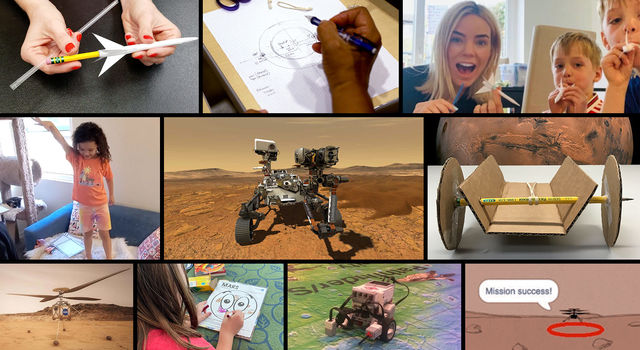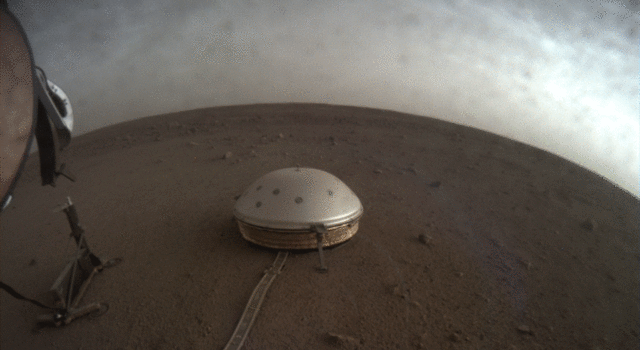Blogs | Dawn Journal | October 29, 2006
October 2006
Dear Dawnvironments,
The Dawn spacecraft is in space! Well, not quite, but it is getting a taste of the space environment, courtesy of the team preparing it for its mission.
Although the individual components of the spacecraft have already been tested, the point of the testing in Orbital Sciences Corporation's Environmental Test Facility is to verify that the fully assembled spacecraft will survive the rigors of launch and be able to fulfill its ambitious mission of exploration in deep space.
When Dawn is on the launch pad at Cape Canaveral and during the brief (but exciting!) trip from there to space, many radio signals between systems on the ground and between ground systems and the rocket will impinge upon it. Some of the tests are designed to verify that these signals will have no adverse effects on the spacecraft. Other tests show that Dawn's electronics do not produce signals that might interfere with these other systems.
As one illustration of the importance of such tests, consider the scientists eager for Dawn's intimate portrait of the enormous asteroids Ceres and Vesta, the team members who have invested years of their lives in creating this spaceship and the means to use it to explore distant worlds, all people who thirst for greater knowledge of our solar system and the thrill of discovery, and taxpayers who make it possible. One may reasonably expect members of all of those groups to find it unsatisfying if any of Dawn's electronics produced signals that accidentally activated the rocket's self-destruct system. (That system is designed to be commanded with radio signals transmitted by range safety in the event of a serious malfunction during ascent.) Similarly, if Dawn's radio emissions interfered with the rocket's reception of range safety's self-destruct command, the legions of Dawnophiles throughout the Milky Way Galaxy, and the even greater number elsewhere, would no longer give this project their loyal support.
In addition to testing Dawn's compatibility with other systems, engineers are testing its self-compatibility. It is essential to verify that none of the subsystems, including the radio used for interplanetary communications, emits electromagnetic radiation that might interfere with other subsystems.
Of course, Dawn's designers and builders were well aware of these and other concerns, and they have methods to make the probe satisfy the many associated requirements, but only through testing may we be confident that the work was successful.
With the completion of testing in the electromagnetic interference/electromagnetic compatibility facility, the spacecraft will be prepared for a series of mechanical tests. For the rocket's control systems to remain stable with Dawn perched at the top, it must be accurately balanced and must meet certain criteria for how stable it is when it is spun, and the next set of tests will help prepare for that. (As we will discuss in an upcoming log in more detail, the spacecraft will spin at about 50 rpm during a portion of the time it is on the rocket.) Also on Dawn's agenda during November are deafening noise and powerful shaking that will show its readiness for the ride to space. Sensors to measure the movements of certain parts of the spacecraft will be installed (after the balance measurements are complete) for these tests.
As we know from earlier logs, between many of these environmental tests, other tests will be conducted on the spacecraft to ensure that its systems remain intact, undamaged by previous environments and ready for the next. At each stage, the health of the spacecraft will be verified.
Dawn's busy autumn includes still another kind of test. Now that it is a complete spacecraft, it is scheduled for tests of its responses to many of the complex sets of commands that will be sent to it while far from Earth. These "mission scenario tests" exercise not only the spacecraft but also many of the software systems used by mission control. While this testing is invaluable, it does have some noteworthy limitations. The spacecraft cannot respond now to all of these commands, because, for example, it cannot rotate itself while on Earth, it cannot see stars to establish its orientation, and the ion propulsion system can thrust only in vacuum. (The ion propulsion system will be operated briefly with the spacecraft in a vacuum chamber early next year.) Sophisticated simulators connected to the spacecraft compensate for these and other limitations of the terrestrial test program.
Important progress has already been made in these tests. The team has demonstrated that commands can move smoothly through the complex path from mission control at JPL, to the spacecraft's main computer and then to its engineering and science subsystems, and that responses can flow back to mission control, to the Dawn Science Center at UCLA, and to the institutions that built the science instruments.
The last log described the spacecraft's engineering subsystems, including a characterization of their relative importance, but what about these science instruments? Some people would say they are more important than any of the engineering subsystems. While others would disagree, everyone would concur that without the science instruments, the long and arduous journey to Vesta and then to Ceres would be of no value without the information these instruments will gather. We'll be seeing much more about them in the years ahead, but let's introduce them now.
Dawn is built and operated by humans who, in contrast to many of our other readers, are very visual creatures. So it is no surprise that the spacecraft carries cameras to share the sights with those who remain at home. (There have been, and will continue to be, many space missions that are fantastically productive and tremendously exciting even without cameras; nevertheless, the visceral appeal of pictures is undeniable.) Besides satisfying our innate curiosity to know what Vesta and Ceres look like, the cameras will provide important data essential to gaining an understanding of the geological and physical properties of these enigmatic bodies. And in the spirit of this mission representing all humankind, and not only those who happen to reside in one portion of one continent, the cameras on Dawn are contributed by Germany. The Max-Planck-Institut für Sonnensystemforschung (Max Planck Institute for Solar System Research) was responsible for their design and fabrication, in cooperation with the Institut für Planetenforschung (Institute for Planetary Research) of the Deutsches Zentrum für Luft- und Raumfahrt (German Aerospace Center) and the Institut für Datentechnik und Kommunikationsnetze (Institute for Computer and Communication Network Engineering) of the Technischen Universität Braunschweig (Technical University of Braunschweig).
Because of the long duration of Dawn's mission and the extraordinarily remote locations in which it will operate (more than one million times farther from Earth than the International Space Station), most of the critical subsystems include backups, thus allowing Dawn to persevere even in the event of a malfunction. The images of Vesta and Ceres are so essential that the probe carries two identical cameras. In addition to the value for science and for the visually oriented fans of the mission, the images are critical for navigating the spacecraft in the vicinity of these bodies.
The cameras incorporate filters in 7 color ranges, chosen principally to help study the minerals on Vesta's surface. In addition to detecting the visible light humans see, the cameras will register near infrared light.
Another scientific instrument, contributed by Italy, covers a still broader range of light, from shorter wavelengths in the ultraviolet through the same wavelengths in which the cameras operate, to farther in the infrared. It is provided by Agenzia Spaziale Italiana (Italian Space Agency), and it was designed and built at Galileo Avionica, in collaboration with the Istituto Nazionale di Astrofisica (National Institute for Astrophysics). Because of its sensitivity across the entire visible (V) spectrum and well into the infrared (IR), the team that designed the instrument has named it VIR ("vir" is Latin for "man").
Each VIR picture records how strong the light is at more than 400 wavelength ranges in every pixel. Instruments such as this are known as imaging spectrometers, and they see the world much as we might if we looked through a prism, which breaks light into its component colors. But this yields more than a beautifully surreal view of extraterrestrial landscapes. When scientists compare VIR's observations of its targets with laboratory measurements of minerals, they can determine what minerals compose the surfaces of Vesta and Ceres.
With the data from the cameras and VIR, scientists will discover much about the nature of those alien worlds, but these highly capable instruments cannot reveal everything we would like to know. To learn still more, Dawn will carry a device that measures the energy of gamma rays and neutrons. Gamma rays are a form of light, not only higher energy than visible, and even higher than ultraviolet, but more energetic even than X-rays. Neutrons are particles that normally reside in the nuclei of atoms (about half of your body weight is neutrons, regardless of how much Halloween candy you eat). Some of the gamma rays and neutrons emitted by Vesta and Ceres are produced by radioactive elements and others are created by the bombardment of the surface material by cosmic rays. As they emanate from the surface and travel into space, some will be intercepted by Dawn's gamma ray and neutron detector (GRaND) which, despite its name, is very humble. (For the sake of having an interesting appellation, it's fortunate that GRaND detects gamma rays and neutrons and not neutrons and gamma rays.) The complex and impressive instrument was designed and built by a team at the Los Alamos National Laboratory.
The gamma rays and neutrons reveal many of the important atomic constituents to a depth of one meter (three feet) or so on Vesta and Ceres, thereby adding to the detailed story Dawn will tell. As we know from the first log, Ceres may be rich in water. If it is, the signature of water may be contained in GRaND's data.
Although there is not a special instrument for it, Dawn will make another set of scientific measurements at its destinations. Using the radio signals exchanged between the telecommunications system (described in the previous log) and NASA's Deep Space Network, scientists can detect subtle variations in the gravitational attraction between each asteroid and Dawn. These variations reflect details of the internal distribution of mass, so these tiny effects allow us to learn about the interior structure of the massive bodies Dawn will orbit.
Dawn is well prepared to help scientists extract a wealth of information about Vesta and Ceres and thus teach us a great deal about the nature of the solar system when planets were forming. In less than 8 months, the craft will be launched on the beginning of its journey to that distant past. While much work remains, each step in the preparations brings us closer to witnessing the thrilling discoveries it will make. I hope you continue to share in the eager anticipation and ultimately in the excitement of the rewards.
Dr. Marc D. Rayman
October 29, 2006
TAGS:DAWN, VESTA, CERES, DWARF PLANET, MISSION, SPACECRAFT







